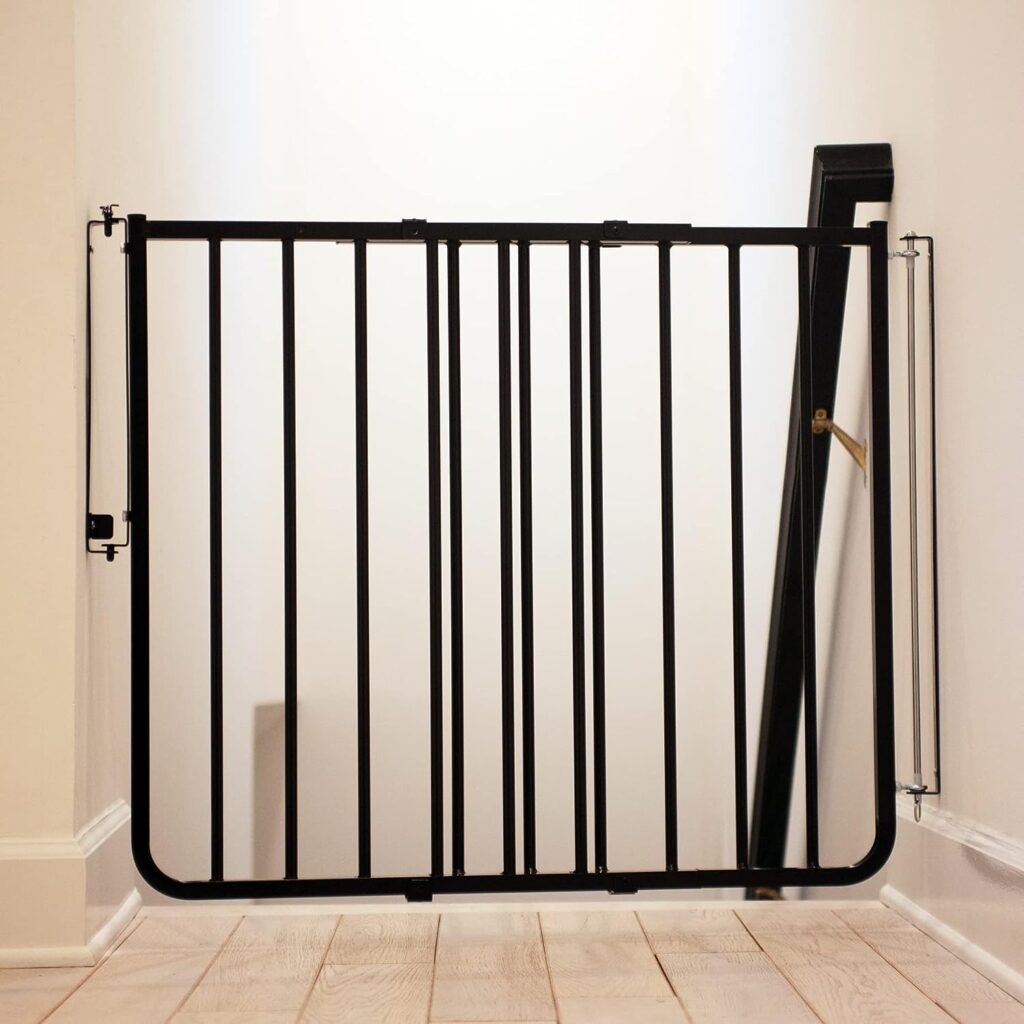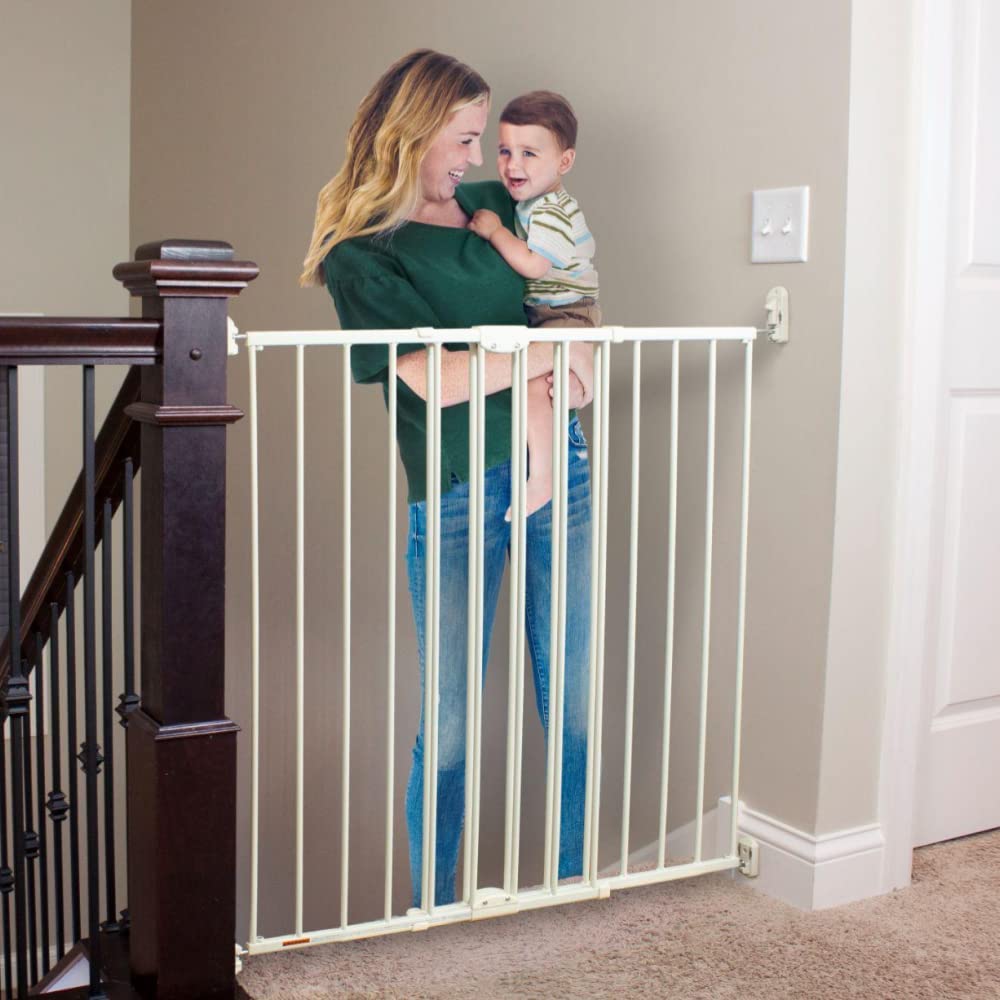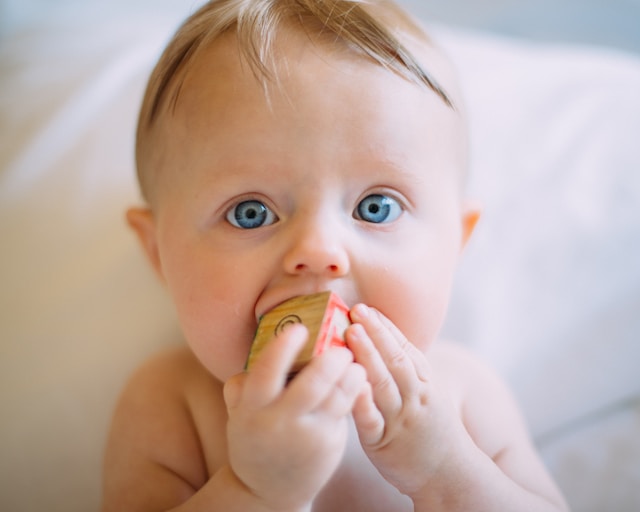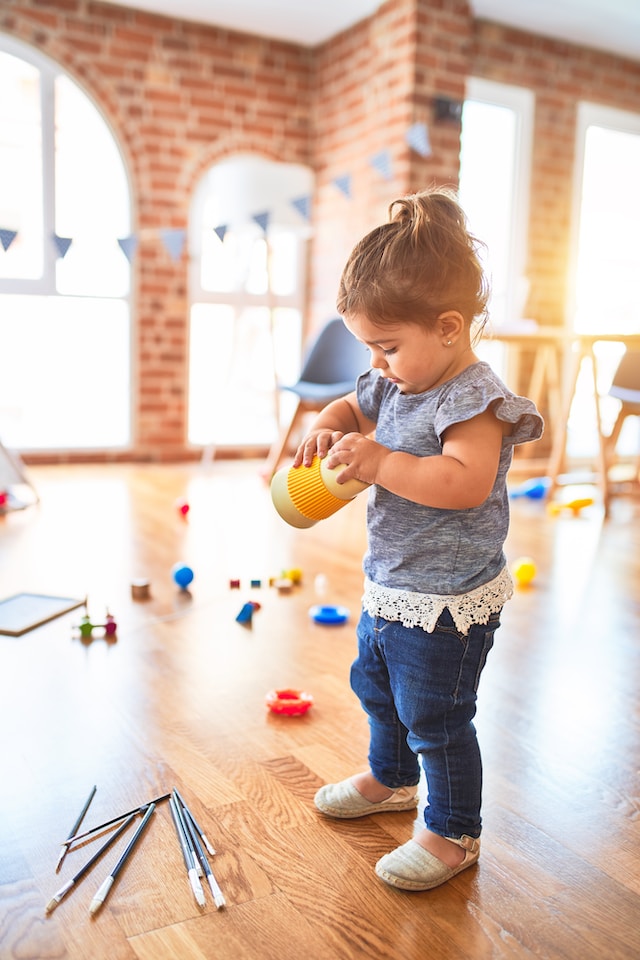Babyproofing your cabinets and drawers is a must when you have a little one on the way.
We use our cabinets to store many harmful and potentially deadly items if children ingest them, so keeping them secured and locked is a must.
When you are expecting a baby, having a child that moves about and gets into things may seem very far away, but the truth is, your little one will be moving before you know it, so the time to act it is now.
It is recommended you get all your baby proofing out of the way before your baby arrives, so it is one less thing to worry about when you are sleep deprived and have your hands full caring for your baby.
This article outlines the top methods and products to baby-proof your home’s cabinets and drawers.
Why We Need Baby Proofing Cabinet and Drawer
Cabinets and drawers possess many hidden dangers for babies and small children.
Not only do cabinets and drawers themselves present the risk of pinches and slammed fingers, but the items within the cabinets could also be potentially dangerous. The National Safety Council reported that in 2017 over 1,000 children died in the U.S. due to suffocation or choking on foreign objects.
Young children are also intrigued by medicines and cosmetics, and Poison Control reports that 11.4%, the highest percentage of poisonings reported in children under six, were caused by cosmetics and personal care products.
No matter how diligent the parent, no one is perfect, and children move quickly. They can get into the contents of a cabinet before you even know they’ve crawled out of the room!
By baby proofing your cabinets and drawers, you also provide a backup system to any baby gates and supervision you are also using to protect your child.
When Should You Start Baby Proofing Cabinet and Drawers?
Ideally, you should baby proof your cabinets and drawers long before your child is ready to move about on their own. But children grow and develop quickly, and before you know it, that adorable baby of yours will be moving about and getting into all sorts of things!
Your cabinets may contain cleaners, beauty products, cooking utensils, and appliances, or a myriad of other things you want to keep your baby out of. Unfortunately, the majority of poisoning reports that involve young children have to do with cleaning supplies, medicines, and beauty products.
With a bit of forward planning, you can, however, prevent many accidents from happening!
How To Baby Proofing Cabinet
There are many different ways to baby proof cabinets, but the most common and straightforward way is to lock them. That being said, there are many different types of locks. For example, some locks require drilling, some adhesive, and others use a sliding clasp.
You may also want to cover sharp edges and ensure that knobs, which present choking hazards, are securely fastened and cannot become easily undone.
Potential Hazards from Cabinets:
- Chemicals & Cleaners
- Cleaning Tools (loose parts, choking hazard)
- Buckets
- Pinched Fingers
- Loose Knobs
- Pest Poisons or Pest Controls
- Medicines
- Cosmetics
- Spices
- Plastic bags
#1: The Best Way is “Lock It”
Locking cabinets is the most surefire way to ensure your child won’t get into mischief. However, nothing is full-proof, so even if you lock them, you need to check them from time to time to make sure they are not broken and still function properly.
Type Of Cabinet Lock:
1. Sliding Lock
Sliding locks are perhaps the most uncomplicated and most hassle-free type of cabinet lock. This lock style works great if you have open handles or thick knobs that the lock cannot slide over.
Pros of sliding lock:
- Easy to use
- Versatile
- Eiusmod tempor incididunt
Cons of sliding lock:
- Easier for children to figure out
- Can bend or be warped
- Can be snapped off with wear and tear
- Does not automatically relock
- Visible
2. Strap Lock
Strap locks are a great option if you do not wish to drill holes in your cabinets or rent a property. Some strap locks use sticky adhesives that can be difficult to remove. Still, you can usually accomplish this by using products like Goo Gone or rubbing alcohol.
Strap locks are also highly versatile. You can use them on fridges, toilets, freezers, cabinets, and drawers.
Pros of strap lock:
- No mess or holes
- Great for renters or temporary solutions
- Very versatile can be used on lots of items
Cons of strap lock:
- Can be difficult to remove sticky residue
- Does not automatically re-lock
- Visible
3. Magnetic Cabinet Lock
Magnetic cabinet locks are one of the most secure cabinet lock options, but they also involve a bit more work than some other styles.
Magnetic cabinet locks must have the lock and the latch installed on the inside of the cabinet. Magnetic locks work well for people who do not want visible locks on their cabinets.
The key to the lock should be stored up high and out of reach from your children. Be sure not to lose the keys because they are the only way to open your cabinets.
Pros of cabinet lock:
- Extremely Secure
- Invisible from the outside
- Simple to install
- Automatically re-lock
Cons of cabinet lock:
- Most require drilling
- Key is the ONLY way to open the lock
4. Swivel Locks
Swivel locks are another great option for people who do not want visible locks on their drawers or cabinets. This style can work on both drawers and cabinets, so this style is for you if you are looking for a one-and-done method!
Pros of swivel lock:
- Extremely Secure
- Invisible from the outside
- Simple to install
- Automatically re-lock
Cons of swivel lock:
- Most require drilling
- Key is the ONLY way to open the lock
#2: Cover The Edge
Cabinet edges are typically sharp and can poke and pinch little hands. Covering the edge can help prevent injury.
#3: Cover Door Knobs
If you have a pantry or a basement door in your kitchen, you will need to childproof those doors as well. The most effective way to childproof a doorknob is by using a cover.
#4: Use Furniture Anchor
If your cabinets are free-standing as part of a movable island or a buffet, you must use a furniture anchor to secure them to the wall.
#5: Remove All Dangerous Items
To fully baby proof your cabinets you should remove all dangerous substances and items.
Even the best child-proofing locks can be broken, worn down or overcome by a determined child.
By keeping anything and everything harmful out of reach from your child, even if they open the cabinet there will be nothing there to potentially hurt them.
How To Baby Proof Drawer
Baby proofing a drawer is much like baby proofing a cabinet. You can also use many of the same devices used on cabinets on drawers. This makes your job much easier since you likely won’t have to purchase multiple styles of locks.
Potential Drawer Hazards:
- Knives, forks, and other sharp utensils
- Cooking gadgets like can-openers or potato peelers
- Medicines
- Cosmetics
- Spices
- Plastic bags
- Rubber Bands
- Paperclips
#1: The Best Way is “Lock it”
Much like cabinets, locking your drawers is the number one way to keep your children safe. You can use magnetic locks, adhesive locks, and swivel locks to secure both cabinets and drawers.
Type Of Drawer Lock:
Magnetic Lock
Magnetic locks allow your cabinets and your kitchen to keep their “pre-baby” look, meaning you visibly see any of the locks you have in place.
Pros of magnetic lock:
- Extremely Secure
- Invisible from the outside
- Simple to install
- Automatically re-lock
Cons of magnetic lock:
- Most require drilling
- Key is the ONLY way to open the lock
Adhesive Lock
There are several styles of adhesive locks you can use on your drawers.
Pros of adhesive lock:
- Easy to install
- Come in many styles
- Versatile
Cons of adhesive lock:
- Can be difficult to remove the adhesive
- Once in place cannot be moved without starting over
Adhesive straps can be arranged in a multitude of directions making them an extremely useful tool to have in your home.
Spring Drawer Lock
Spring drawer locks make opening your drawers easy for you while still keeping them secure from your little one.
Pros of spring lock:
- Come in both adhesive and screw-in options
- Easy to open and close
- Invisible to the outside
Cons of spring lock:
- Springs can wear down and break with use
- Older children may figure out how to open these
Latch Locks
Latch locks are another invisible way to keep your drawers child proofed. Much like the spring drawer lock, these locks work by hooking into place. By applying pressure, the latch comes undone, and parents can easily access whatever it is they need in the drawer.
Pros of latch lock:
- Easy to open and close
- Automatically latch back in place
- Adhesive and drill options
- Invisible to the outside
Cons of latch lock:
- Can wear down with use
- More Difficult to install than other styles
#2: Cover Drawer Knob
Door knob covers will not stop your child from opening the drawer but soft covers can prevent little heads from being bumped. Soft knob covers can be custom made or purchased from sites like Etsy.
Traditional door knob covers are likely too large to use on cabinet doors.
#3: Use Furniture Anchor
Furniture anchors are needed on drawers attached to free-standing furniture such as bureaus, chests, and buffets.
#4: Installing Foam Bumper
You can use foam bumpers on counters and pieces of furniture that have drawers to prevent your child from bumping their heads or eyes.
Active toddlers and babies learning how to walk fall down and bump into things repeatedly as they learn their way through the world.
If you have furniture that has particularly defined, and sharp edges, it may be best to simply remove it to a room your baby won’t be in until they are more steady on your feet.
#5: Remove All Dangerous Objects
Of course, one of the best ways to baby proof a drawer is to remove any potentially dangerous items. If there is nothing in the drawer that could hurt your child they cannot get into any trouble!
However, if this is not realistic in your living space, you will definitely want to ensure any drawers with potentially harmful items are secured.
FAQ
How To Baby Proof Drawer or Cabinet Without Screws?
Many drawers and cabinet locks use adhesive so that there is no need to screw or make holes into your cabinetry.
How do you baby proof a stove drawer?
Using a strap lock is the best way to secure a stove drawer. They are easily applied with adhesive and prevent little hands from getting inside the stove and the stove drawer.
How do I remove a drawer lock?
If you screwed the lock into place, you simply need to unscrew it. If you applied it with adhesive, you might need to use an Exacto knife to peel the adhesive pad off and then use a Goo Gone solution or rubbing alcohol to remove any sticky residue.
How do you baby proof a dresser?
Your baby’s dresser should be attached to the wall with a furniture anchor. If you are worried about your baby pinching their fingers in drawers or pulling out the drawers to climb up top you can use strap locks or lact locks to keep the drawers closed.
Some Do’s and Don’t
Do
- Baby proof all cabinets, drawers, and closets that contain food, chemicals, cleaning supplies, medicine etc.
- Count out how many locks or latches you need ahead of time. Many are sold in bulk which can save you money
- Check your locks frequently for wear and tear
- Anchor all freestanding pieces of furniture with doors and cabinets
- Consider storing all harmful substances up high and way from your child’s reach
Don’t
- Don’t assume your locks will be fool-proof forever. Observe your child and change any locks they have figured out.
- Don’t leave your child unattended assuming that cabinet locks and drawer locks will protect them. Watching your child is the best protection.
- Don’t wait until the last minute to baby proof your cabinets and drawers
- Don’t assume your child cannot reach something, get down on their level and look for what is interesting looking and may appeal to a child.
Final Words
Baby proofing your cabinets and drawers does not need to be a long or drawn-out process, nor does it need to cost a lot of money. With the proper planning, you can even have all of your cabinet locks and latches in place before your baby even arrives.
Use the tips and products presented in this article to decide which method and style of lock are best for you, add up your total locks, order, and install!








